Five Points in 1827 as depicted in Valentine's Manual, 1855
The Old Brewery, from The Old Brewery and the New Mission House at the Five Points, by Ladies of the Mission
Named for the points created by the intersection of Park, Worth, and Baxter streets, the neighborhood was known as a center of vice and debauchery throughout the nineteenth century.
View of Collect Pond in 1798 after Alexander Robertson looking southwest (from Baxter and Bayer St.).
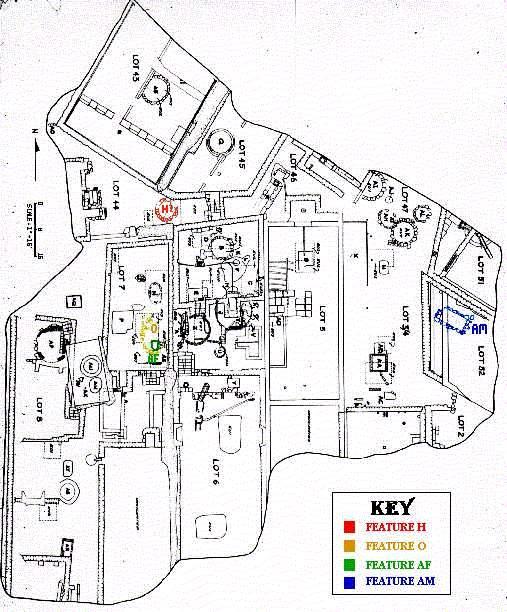
Diagram of Courthouse Block excavation showing foundation walls and excavated features.
Overview of 1991 archaeological excavation showing foundations and features on lots 6 and 7 - 472 and 474 Pearl Street
Portion of Maerschalk's "Plan of New York" showing a row of tanneries along the Collect Pond outlet
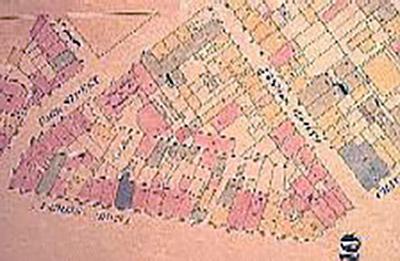
Block 160 as it appears in an 1857 Perris insurance map
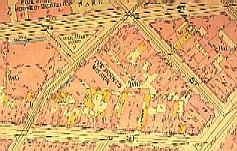
Block 160 as it appears in Bromley's 1902 insurance map
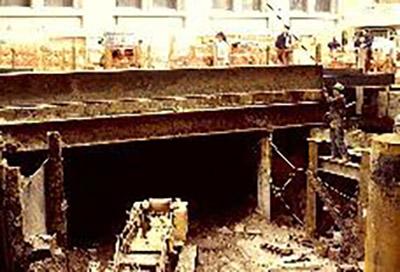
Entrance to the tunnel excavation beneath Pearl Street, looking northeast toward the courthouse across the street
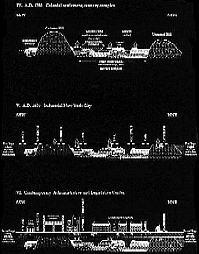
Diachronic model of land use and occupation, A.D. 1750 - Present, from Geoarchaeological reconstruction of the Five Points area by Joel Schuldenrein.
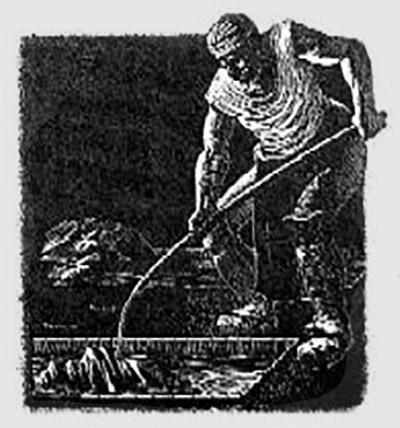
Artist's impression of tanyard worker from The Tanners by Leonard Everett Fischer — note the long hooked tool the tanner is using to handle the hides

A barrel made of Eastern white pine slats was found at the northeast corner of the tunnel trench; it had been buried in the ground, and probably held the liming solution that was used to loosen the hair from the hides before they were tanned
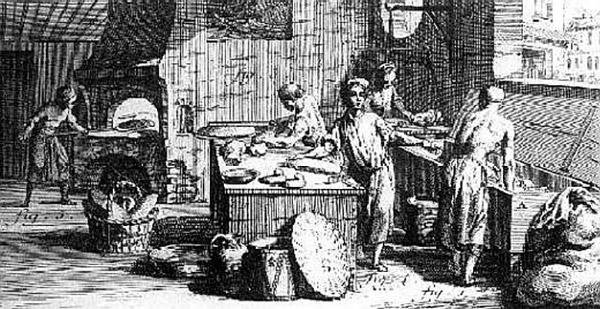
Bakery illustration from Diderot’s mid-eighteenth century encyclopedia
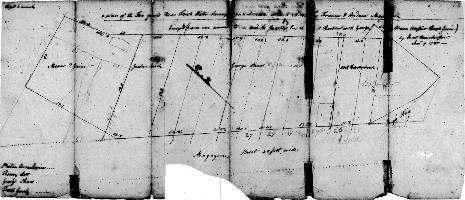
The Shaw’s property is marked in the center of this 1785 tannery map of the courthouse block
MCC Tunnel cattle horn cores and miscellaneous bone found buried in a stratum composed of shredded oak bark.
MCC Tunnel A nearly complete canine skeleton - often found in association with historic tanneries.
MCC Tunnel cattle horn cores and miscellaneous bone found buried in a stratum composed of shredded oak bark.
MCC Tunnel wooden slat from the barrel identified as a liming pit that was found at the northeast corner of the tunnel trench
MCC Tunnel iron hook, which would have been attached to a long wooden handle, used to move hides around in the tanning vats.
The Hoffman Assemblage hand-painted pearlware tea set, made in England, 1795-1825.
The Hoffman Assemblage matching creamware, made in England, 1760-1810.
The Hoffman Assemblage Chinese porcelain dinnerware, 1780-1800
The Hoffman Assemblage matching creamware, England 1760-1810
The Hoffman Assemblage Pearlware pitcher, Willow pattern, made in England, 1790-1840
The Hoffman Assemblage two flips with Stiegel-like engraved decoration and pattern-molded fluting, late-18th century
The Hoffman Assemblage unusual Lynn-decorated tumbler, late-18th century
The Hoffman Assemblage two Flips (Left and Center) and a Tumbler (Right)
The Hoffman Assemblage 18th century wine glasses, one pattern molded (left) and two with air twist stems (right)
The Hoffman Assemblage tumbler and two 18th century wine glasses
The Hoffman Assemblage dessert glass with pattern-molded ribbing, 18th century
The Hoffman Assemblage salt cellar (top view/side view), late-18th century
The Hoffman Assemblage salt cellar, late-18th century
The Hoffman Assemblage case bottle (probably for gin), made in Holland, late-18th to early-19th century
The Hoffman Assemblage scent bottle, late-18th century
The Hoffman Assemblage medicinal vials, late-18th century
The Hoffman Assemblage preserved food, snuff, or powdered condiment bottle, late-18th to early-19th century
The Hoffman Assemblage porcelain tobacco pipe bowl, made in Germany, late-18th to early-19th century
The Hoffman Assemblage long stemmed, white clay tobacco pipes, late-18th to early-19th century
Early-20th century courtyard from The Tenement House Problem by DeForest and Veiller (1903)
Feature O, a stone-lined privy, located on lot 7 (474 Pearl Street)
Richard Barry’s saloon at 488 Pearl Street in 1858, described by Harper’s Weekly as a place where “regular Democrats” wrested working-class votes
Harper's Weekly interpretation of tenement life during a heat wave (1879)
Irish Tenement and Saloon matching white granite teaware set, made in England, 1840-1860
Irish Tenement and Saloon yellow ware mug; transfer-printed child's cup from the "Games and Pastimes" series (England, ca. 1820); luster ware creamer; and yellow ware (mocha) mug
Irish Tenement and Saloon transfer-printed teawares in common Staffordshire patterns, 1830-1867
Irish Tenement and Saloon white granite chamber pot and lid
Irish Tenement and Saloon stoneware beer bottles
Irish Tenement and Saloon yellow ware spittoon (American made)
Irish Tenement and Saloon pepper sauce bottle decorated in the Gothic style, 19th century
Irish Tenement and Saloon embossed medicinal bottles
Irish Tenement and Saloon proprietary medicinal bottles and vials
Irish Tenement and Saloon embossed patent medicine bottles
Irish Tenement and Saloon figured cologne, and scent bottle, 19th century
Irish Tenement and Saloon - Soda water bottles, 19th century
Irish Tenement and Saloon Artifact - 19th-century glass ink bottles; master inks (rear), three umbrella bottles (left front), and a rectangular embossed bottle from T.DAVIDS of New York (right front).
Irish Tenement and Saloon Artifact - Umbrella part, collar stay, and buckle.
Irish Tenement and Saloon Artifact - Faux gemstone, glass hygienic syringe, and bone lice comb.
Irish Tenement and Saloon Artifact - Clay and glass marbles.
Irish Tenement and Saloon Artifacts - A variety of common 19th-century clay pipes, including a bowl molded into a bearded man's head, a Dutch "Peter Dorni" style pipe, and several fluted styles.
Irish Tenement and Saloon Artifact - Complete examples of two clay pipes; a 19th-century fluted variety, and a "Peter Dorni" style made in Gouda, Holland after 1850.
Corner of Pearl and Chatham Streets, 1861, as depicted in Valentine’s Manual, 1883
Marketing at Five points, circa 1850, from John Duffy's A History of Public Health in New York
A Five Points oyster cellar, from George Foster's New York by Gas-light (1850)
Five Points, circa 1875, from Lightfoot's Nineteenth-Century New York in Rare Photographic Views (1981)
A Chatham Street Oyster House staffordshire vegetable plate decorated with the "Castle of Saint Angelo" pattern, 1840s
A Chatham Street Oyster House "Old blue" saucer with Lafayette contemplating the tomb of Franklin, French series, Staffordshire, 1824-1835
A Chatham Street Oyster House "Old blue" pitcher with Lafayette contemplating the tomb of Franklin, French series, Staffordshire, 1824-1835
A Chatham Street Oyster House red earthenware porringers
A Chatham Street Oyster House red earthenware pitcher
A Chatham Street Oyster House red earthenware bank
A Chatham Street Oyster House red earthenware pie plate
A Chatham Street Oyster House earthenware chamber pot
A Chatham Street Oyster House tumblers
A Chatham Street Oyster House wine or olive oil bottle
A Chatham Street Oyster House wine bottles
A Chatham Street Oyster House - Flacon, probably used to store capers or olives
A Chatham Street Oyster House - Clay tobacco pipe decorated with thistle and rose motif, made in Linclonshire, England, 19th century
A Chatham Street Oyster House - Clay tobacco pipe with aboriginal figures molded on bowl, made by Thomas Balme of East London, 1805-1840
A necktie workshop in a Davidson Street tenement, from Jacob Riis’ How the Other Half Lives (originally published in 1890)
A Ludlow Street sweat shop, from Jacob Riis' How the Other Half Lives (originally published in 1890)
Harper’s Weekly image of family members carrying garments home to be sewn together (1890)
Feature H, a stone-lined privy, located at Number 8 Baxter Street (lot 45)
Many Italian immigrants made a living as organ grinders or street musicians, but social reformers campaigned against monkey training schools. One such school is depicted in this illustration from Harper's Weekly
Needle Trades To Street Musicians - Remains of a New World Cebus monkey
Needle Trades To Street Musicians - Mother of Pearl buttons
Needle Trades To Street Musicians - Sewing related objects, including thimbles, papers of pins, clasps, bone and glass buttons, and a carved tambour (embroidery) hook
Needle Trades To Street Musicians Pressed glass buttons
Needle Trades To Street Musicians Bias tape
Needle Trades To Street Musicians Black cotton thread
Needle Trades To Street Musicians Twill cloth fragment
Needle Trades To Street Musicians "Shoddy" cloth fragment
Lower Hudson Street, c. 1865, from Old New York in Early Photographs
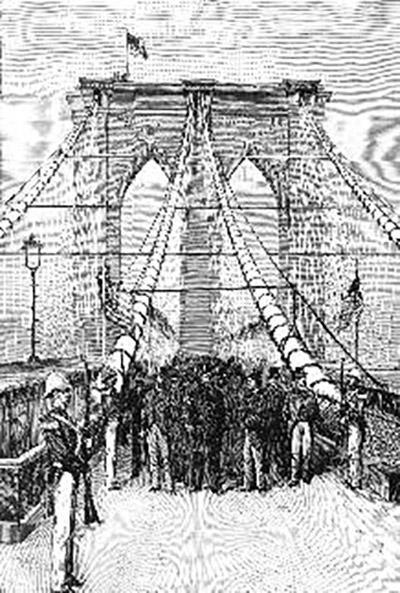
Opening Ceremonies on the Brooklyn Bridge, from Harper's Weekly, June 2, 1883
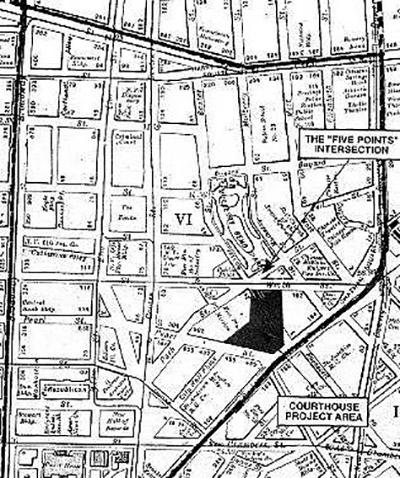
A map of Manhattan’s Sixth Ward, highlighting the Five Points intersection and the Courthouse Block project area
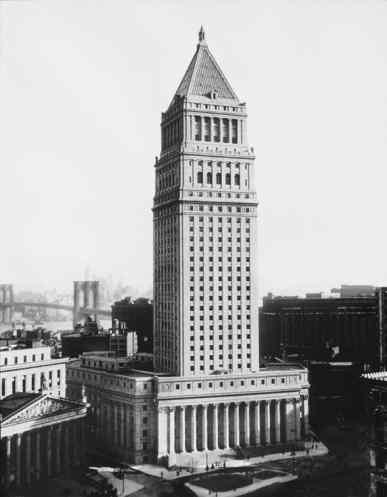
Thurgood Marshall U.S. Courthouse at 40 Foley Square, erected over part of the old Five Points neighborhood by the U.S. General Services Administration.
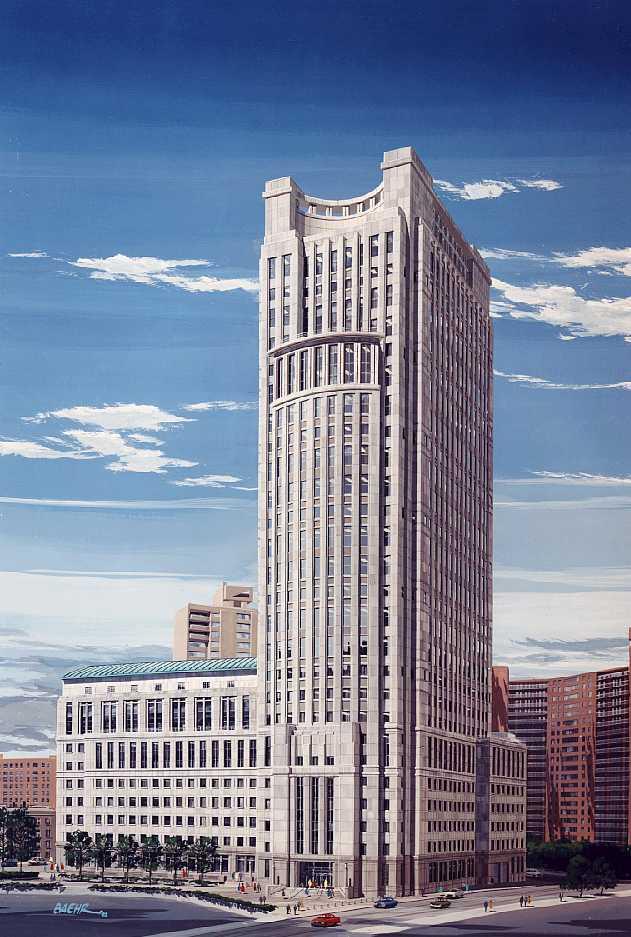
Moynihan U.S. Courthouse, Erected over part of the old Five Points site.

 U.S. General Services Administration
U.S. General Services Administration